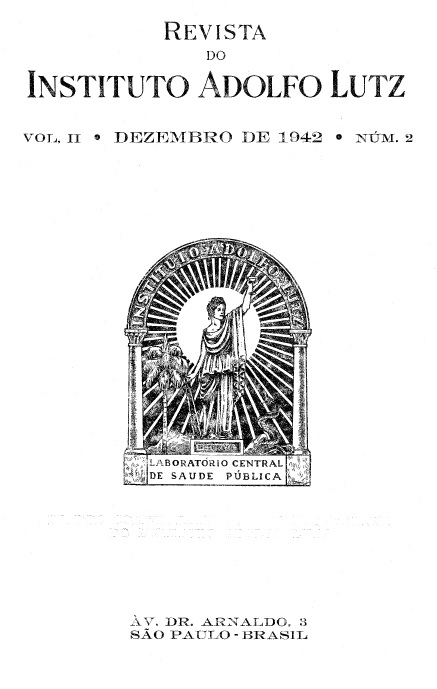Abstract
The bone-marrow culture is of the greatest value to the diaggnosi of typhoid-fever, its sensibility during the feverish periods being absolute.In the first weeks of the disease, it showed positive results in more than 80% of the cases. We obtained positive results from the 8th to the 48th day of the disease. As a method for diagnosis, the bone-marrow culture proved to be much more sensible than the simple blood-culture. The Widal reaction must always be made with "O" and "H" antigens. The authors present two cases where the diagnosis of typhoid fever could not be ascertained, although their "H" agglutinin rate was high. Typhoide fever produces slight leucopenia, considering 7.077 leucocytes per cmm. as the medium rate during the diferent stages of the disease. When the disease evolves with no complications, we may observe at first a quantitative decrease of the leucocytic rate, while in the last weeks, this rate rises to normal and even higher value; when complications occur, total rates are leucopenic. Typhoid bacilli inhibit myeloid maturation: when no germs are present in the bone-marrow, global counts are high. Generally there is a relative neutrophilia; in peripheric blood the presence of immature elements as myelocytes and metamyelocytes occurs; also there is a remarkabIe number of stab and a decrease of segmented neutrophiles. In addition we may observe the presence of toxic granulations, cytoplasmic and nuclear microvacuolation, protoplasmic basophilia, nuclear picnosis, PeIger-Huet nuclear anomaly, anisocytosis and poikilocytosis of the granulocytes. The degenerativ index falls with the advancing of the clinicaI cuer. Parallel to the relative neutrophilia there is neutrophile hiperplasia in the bone-marrow, with preponderance of the more immature elements (promyelocytes) and a slightly anaplastic picture. An absolute peripheric eosinopenia is observed in the first stages of the disease, with reappearance of the eosinophiles in the last weeks; in the bone-marrow the eosinophile rate was normal or slightly increased during the whole course of the illness. In the beginning of typhoid there is lymphopenia; from the 4th week on there is slightly prevailing lymphocytosis which persists during convalescence. In complicated cases lymphopenia persists to the last stages of the disease. Pro-lymphocytes appear and nuclear and cytoplasmic alterations of lymphocytes take place; in the bone-marrow there is hiperplasia of the lymphocytic line. A relative monocytosis is observed, with marked cytoplasmic microvacuolation. Plasmoblasts and plasmocytes appear in the various stages of the disease. Histiocytes appear in peripheric blood as a resuIt on myeloid histiocytosis.
References
1. SACKS & HACHTEL- 1941 - J. Lab. e Clin. Med. XXVI, 71.
2. KAHN -- 1941 - J. Lab. Cli. Med., XXVI, 139.
3. CARVALHO LIMA - 1938 - Brasil Médico, LI! - 1184.
4. BIEN - 1924 - Cent. f. Bakt., XLIII, 196.
5. CARVALHO LIMA - 1936 - Publicações Médicas, LXXXV, 6.
6. ALESCA & MANOLIU - 1935 - Arch. Roum. Path. e Microb., VIII, 189. Cirur. XXXIX, 87.
6. ALESCA & MANOLIU - 1935 - Arch. Roum. Path. e Microb. - VIII, 189.
7. GILBERT, COLEMANN & LAVIANO - 1934 - J. Lab. e Clin. Med., XIX, 225.
8. LEON C. HAVENS - 1935 - The bacteriology of T'yphoid, salmonella and dysentery infectius, New York, The commonwealth, Fund.
9. LANDAU & BAUER - 1940 - Presse Médicale, n.0 6, 71.
10. NAEGELI, O. - 1921 - Blutkrank und Blutdiagnostik, Berlim, Spinger.
11. ScHLLING- El cuadro Hematico y su valor en la clínica Labr. Barcelona.
12. FIESCHI - 1938 - Semeiologia del midollo osseo Cooperativa, Pavia.
13. FERRATA - 1938 - Le Emopatie - Soc. Ed. Lemb. Milano.
14. ÜRIA, J. - 1934 - Comentarias e observações sobre Plasmócitos e Elementos Plasmocitóides no sangue circulante. Rev. Assoc. Paul. de Med., 4,64-67.
15. STORTI e DE FILIPPI - Ricerche morfologiche e batteriologiche sul midollo osseo dei malatti di ileotifo. Policlinico, Sez. Pratica, nº 19, pg. 937.

This work is licensed under a Creative Commons Attribution 4.0 International License.
Copyright (c) 1941 Instituto Adolfo Lutz Journal
